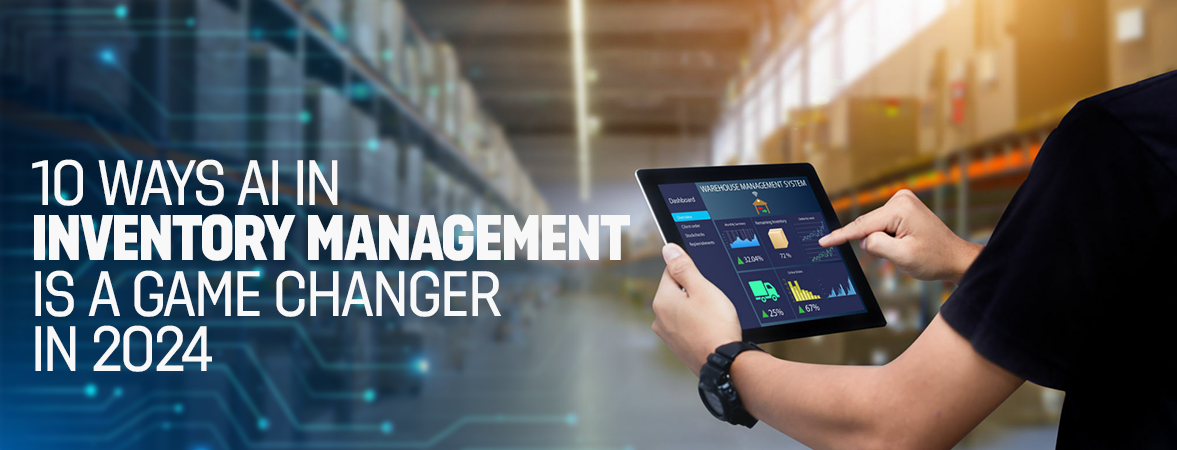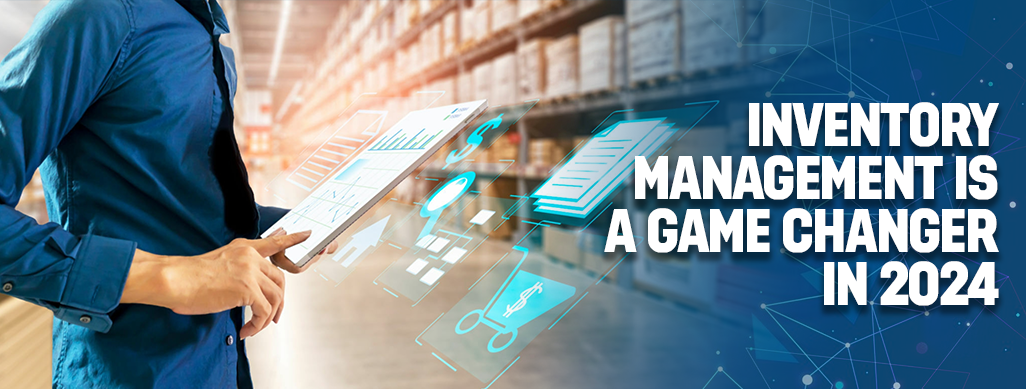
We use cookies to ensure that we give you the best experience on our website.
By using this site, you agree to our use of cookies. Find out more.
In this blog, we will explore 10 significant ways artificial intelligence is serving as a game changer for inventory management operations.

Artificial intelligence is revolutionizing industries across sectors. As 2023 comes to an end, AI Mobile App Development has increasingly been deployed over the past year to transform inventory management approaches for businesses. As we embark into 2024, AI capabilities continue to rapidly advance and bring unprecedented changes. In this blog, we will explore 10 significant ways Artificial Intelligence is serving as a game changer for inventory management operations. From real-time tracking to predictive analytics, AI is enabling companies to take their supply chain efficiencies to new heights.
AI is significantly enhancing the efficiency of inventory management operations. By analyzing huge troves of structured and unstructured data from various sources, AI provides deeper insights into patterns of demand, supply, and performance that weren't visible before. It allows for more accurate demand forecasting and fine-tuned replenishment decisions. Artificial Intelligence also automates repetitive tasks like purchase orders, receipts, and cycle counts and enables round-the-clock monitoring of inventory levels and movements. This early detection of variances helps reduce risks of stock-outs or overstocking.
Furthermore, AI is optimizing resource allocation and warehouse workflows using tools like automated guided vehicles to maximize space utilization and fulfillment speeds. All these factors contribute to improved turnaround times, higher inventory accuracy, lower holding costs and better customer service. The impacts being seen through early AI adoption are helping establish its tremendous potential for fundamentally changing supply chain efficiencies.
Here are 10 ways AI revolutionizes inventory management

Artificial Intelligence has allowed for real-time management of inventory levels through various algorithms and predictive analytics. By continuously monitoring sales patterns, shipping details, inventory on hand and several other inputs, AI keeps track of inventory in a live, dynamic manner.
This allows businesses to instantly see how inventory is changing across all locations due to shifts in demand, returns or other adjustments. They can proactively make decisions like re-ordering quantities just in time or re-allocating stock between outlets to ensure optimal levels at all times. With AI, managers no longer have to wait for fixed time periods to check inventory reporting. They gain real-time visibility to stay on top of inventory flows.
AI plays a crucial role in risk management for inventory by helping businesses stay ahead of potential issues. Using techniques like predictive modeling and big data analysis, AI helps the Mobile App Development Company assess risk factors pertaining to inventory like fluctuating demand cycles, supply chain delays, seasonal variations etc. It can analyze historical trends to predict the probabilities of different risks like overstocking, stock-outs, wastage etc.
Armed with these insights, the company can proactively take preventive actions and make contingency plans to mitigate future risks. This enhances inventory control and ensures uninterrupted product availability. AI brings more objectivity to risk evaluation, which is important for the Mobile App Development Company to optimize costs.
AI has significantly improved demand forecasting abilities for inventory management. By analyzing past sales patterns, customer demographics, market trends, historical price elasticities, promotional period sales and even external factors like weather or competitor activity, AI can make highly accurate projections of future demand. This gives businesses clearer visibility into how much inventory they need to stock for upcoming periods.
The AI-based forecasts also give lead time to make suitable production or purchasing adjustments. As it considers more data points autonomously, demand prediction through AI is easier and more efficient than manual efforts. This enables preemptive steps to meet demand optimally.
The Mobile App Development Company has implemented AI-powered robots in its warehouses to automate inventory management processes. The robots utilize machine vision, sensors and predictive algorithms to identify products, read barcodes, scan shelves and retrieve or store items efficiently.
AI orchestrates the robots' movements and assigns tasks autonomously based on real-time inventory data and order requirements. This has enabled smarter utilization of warehouse space and faster order fulfillment. The robots work continuously without breaks, ensuring round-the-clock operations. Their precision and speed has drastically improved productivity compared to manual sorting and order picking. AI is transforming the Mobile App Development Company's warehouses into smarter, highly automated logistics hubs.
AI has enabled effective data mining for inventory management. It allows companies to extract valuable insights by studying massive amounts of both structured and unstructured internal and external data sources. AI algorithms can analyse customer purchase histories, demographic details, product attributes, sales records, seasonal trends, market reports and more to determine relationships and patterns. This provides deep understanding of demand drivers, purchasing behaviours and expectations.
By leveraging AI, previously untapped data becomes useful for inventory planning. Predictive analysis of mined data helps anticipate demand shifts in real-time and make proactive procurement decisions. Data mining through AI ensures inventory remains in sync with customer needs.
AI brings more objectivity and reproducibility to inventory management processes. By analyzing vast amounts of data, it can surface insights that may not be apparent to humans alone. AI also enables tracking decisions and their outcomes over time. This fosters increased transparency within organizations. Managers can clearly see the logic and factors behind recommendations. AI also handles anomalies and edge cases calmly based on patterns, avoiding biased decisions. This builds trust that inventory policies are fair and data-driven. With AI, stakeholders have visibility into inventory flows and rationales. They can trust the system is optimizing efficiently while facing minimal human errors or inconsistencies.
AI applies machine learning to datasets containing equipment performance history and conditions. It identifies patterns indicating potential failures. By continuously monitoring operational parameters of machines like sensors data, vibrations, temperatures etc., AI can predict maintenance needs even before a defect occurs. This predictive capability enables addressing issues proactively through scheduled upkeep.
By detecting minor issues early, AI prevents major breakdowns and loss of productivity. For inventory managers, AI eliminates disruptive surprises and ensures smooth workflow of sorting, packing and shipping equipment. Predictive maintenance through AI minimizes downtime and optimizes capital equipment lifespan.
AI enhances how companies manage relationships with their suppliers. By analyzing figures on past deliveries like order amounts, lead times, fill rates and invoices, AI picks up trends and anomalies that may impact inventory. It provides insights to procurement teams on which suppliers consistently meet delivery deadlines and quality standards. AI also monitors supplier contracts to ensure all terms are being fulfilled.
With better visibility, businesses can identify issues early on and work with suppliers to address them before they escalate. The transparency AI provides builds trust between all parties involved. Overall, it strengthens collaboration and communication between a company and its supplier network.
AI and machine learning allows companies to personalized prices at scale depending on constantly changing market conditions. By analyzing huge amounts of internal data like inventory levels, sales figures as well as external data sources like weather, competitor pricing and customer demographics, AI can adjust prices in real-time to optimize profitability. It might mean lowering prices temporarily to clear excess stock or raising them for in-demand items to capture value.
AI ensures prices are tailored within set parameters for each customer segment and product category. This type of dynamic, data-driven pricing would be near impossible for humans to manage manually. It helps companies sell more while making automatic price adjustments.
AI helps optimize order fulfillment by intelligently routing each order to the best distribution center. It considers current inventory levels across all facilities in real-time, delivery timelines, shipping costs and other complex factors. The goal is to pick the distribution center that can deliver the order to the customer the fastest at the lowest cost. This type of decision making at scale would overwhelm human workers.
AI finds the most efficient solution so businesses experience higher customer satisfaction, fewer delayed orders and optimized distribution center performance overall. Order optimization is another area where AI delivers significant value for inventory managers.
While AI provides immense opportunities to optimize inventory management, its implementation also faces several challenges that must be addressed for successful adoption. Some of the key challenges include:
As AI and data analytics continue to evolve at a rapid pace, the Future of Artificial Intelligence in inventory management is set to be even more transformational. Some key trends that will impact inventory management in the coming years include:
AI has already proven to be a hugely disruptive force in improving how businesses manage their inventories. Advanced technologies over the past year have removed many of the traditional bottlenecks that have long challenged operations. As we move further into 2024, inventory managers can expect AI to play an even more central role in optimizing processes across every aspect of the supply chain. For companies seeking to gain these competitive advantages, investing in AI solutions has become imperative.
Leave a Comment
Your email address will not be published.